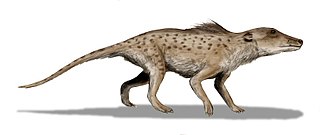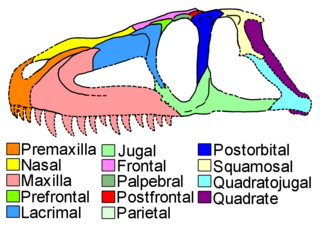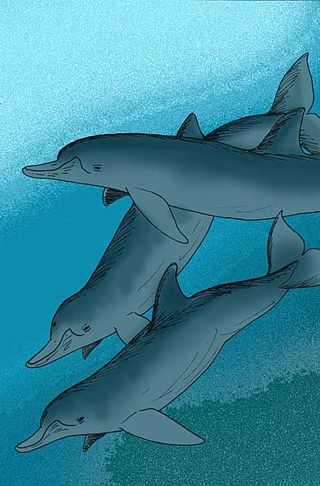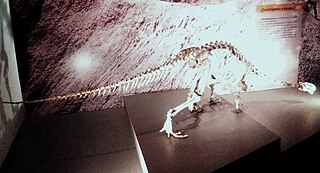
Pakicetidae is an extinct family of Archaeoceti that lived during the Early Eocene in Pakistan. Unlike modern cetaceans, they had well developed limbs and were capable of walking.

Ambulocetus is a genus of early amphibious cetacean from the Kuldana Formation in Pakistan, roughly 48 or 47 million years ago during the Early Eocene (Lutetian). It contains one species, Ambulocetus natans, known solely from a near-complete skeleton. Ambulocetus is among the best-studied of Eocene cetaceans, and serves as an instrumental find in the study of cetacean evolution and their transition from land to sea, as it was the first cetacean discovered to preserve a suite of adaptations consistent with an amphibious lifestyle. Ambulocetus is classified in the group Archaeoceti—the ancient forerunners of modern cetaceans whose members span the transition from land to sea—and in the family Ambulocetidae, which includes Himalayacetus and Gandakasia.

Mesonychia is an extinct taxon of small- to large-sized carnivorous ungulates related to artiodactyls. Mesonychians first appeared in the early Paleocene, went into a sharp decline at the end of the Eocene, and died out entirely when the last genus, Mongolestes, became extinct in the early Oligocene. In Asia, the record of their history suggests they grew gradually larger and more predatory over time, then shifted to scavenging and bone-crushing lifestyles before the group became extinct.

Pakicetus is an extinct genus of amphibious cetacean of the family Pakicetidae, which was endemic to Indian Subcontinent during the Ypresian period, about 50 million years ago. It was a wolf-like mammal, about 1–2 m long, and lived in and around water where it ate fish and other animals. The name Pakicetus comes from the fact that the first fossils of this extinct amphibious whale were discovered in Pakistan. The vast majority of paleontologists regard it as the most basal whale, representing a transitional stage between land mammals and whales. It belongs to the even-toed ungulates with the closest living non-cetacean relative being the hippopotamus.
Nalacetus is an extinct pakicetid early whale, fossils of which have been found in Lutetian red beds in Punjab, Pakistan. Nalacetus lived in a fresh water environment, was amphibious, and carnivorous. It was considered monophyletic by Cooper, Thewissen & Hussain 2009. It was said to be wolf-sized and one of the earliest forms of the order Cetacea.
Gandakasia is an extinct genus of ambulocetid from Pakistan, that lived in the Eocene epoch. It probably caught its prey near rivers or streams.

Sinonyx is a genus of extinct, superficially wolf-like mesonychid mammals from the late Paleocene of China. It is within the family Mesonychidae, and cladistic analysis of a skull of Sinonyxjiashanensis identifies its closest relative as Ankalagon. S.jiashanensis was discovered in Anhui province, China, in the Tuijinshan formation.

Anarosaurus is an extinct genus of pachypleurosaurs that lived in the Middle Triassic period (Anisian) and has been found in the Jena Formation and the Karlstadt Formation of Germany and the Winterswijk Quarry of The Netherlands. Two species are known: A. pumilio and A. heterodontus. The holotype of A. pumilio was originally housed at the Institut und Museum fur Geologie und Palaontologie, Georg-August-Universitat, Gottingen, but can no longer be located today because it was lost or destroyed during World War II. Anarosaurus was a small reptile with an estimated body length of 50–60 cm (1.6–2.0 ft).

Luperosuchus is an extinct genus of loricatan pseudosuchian reptile which contains only a single species, Luperosuchus fractus. It is known from the Chañares Formation of Argentina, within strata belonging to the latest Ladinian stage of the late Middle Triassic, or the earliest Carnian of the Late Triassic. Luperosuchus was one of the largest carnivores of the Chañares Formation, although its remains are fragmentary and primarily represented by a skull with similarities to Prestosuchus and Saurosuchus.

Australodelphis mirus is an extinct Pliocene dolphin. A. mirus is known from fossils found in the Sørsdal Formation, Mule Peninsula, Vestfold Hills, East Antarctica. The genus has been described as an example of convergent evolution with beaked whales.

Adeopapposaurus is a genus of plateosaurian dinosaur from the Early Jurassic Cañón del Colorado Formation of San Juan, Argentina. It was similar to Massospondylus. Four partial skeletons with two partial skulls are known.

Rapaxavis a genus of enantiornithine bird. It has been found in the Jiufotang Formation in Liaoning, People's Republic of China.

Attockicetus is an extinct genus of remingtonocetid early whale known from the Middle Eocene (Lutetian) Kuldana Formation in the Kala Chitta Hills, in the Attock District of Punjab, Pakistan.
Carolinacetus is an extinct protocetid early whale found in the Bartonian Tupelo Bay Formation in Berkeley County, South Carolina.
Eocetus is an extinct protocetid early whale known from the early-late Eocene Giushi Formation in Gebel Mokattam, outside Cairo, Egypt. Fossil remains have also been discovered in the Aridal Formation of the Sahara Desert in southwestern Morocco.

Anthracosuchus is an extinct genus of dyrosaurid crocodyliform from the Paleocene of Colombia. Remains of Anthracosuchus balrogus, the only known species, come from the Cerrejón Formation in the Cerrejón mine, and include four fossil specimens with partial skulls. Anthracosuchus differs from other dyrosaurids in having an extremely short (brevirostrine) snout, widely spaced eye sockets with bony protuberances around them, and osteoderms that are smooth and thick. It is one of the most basal dyrosaurids along with Chenanisuchus and Cerrejonisuchus.

Arktocara is an extinct genus of river dolphin from the Oligocene epoch of Alaska, containing one species, A. yakataga. Having been discovered in 25-million-year-old strata near the 60th parallel north, it is perhaps the oldest-known crown toothed whale and the northmost river dolphin discovered. It was a member of the now-extinct family Allodelphinidae, along with the genera Allodelphis, Goedertius, Ninjadelphis, and Zarhinocetus. It measured approximately 2.26 or 2.28 meters, comparable to its closest living relative, the South Asian river dolphin, which measures 2.4 meters (7.9 ft). However, the animal probably had an elongated beak and neck, so it may have been longer. The animal is known only from a partially preserved skull. Its ecology may have been similar to the modern-day Dall's porpoise, and it may have competed with contemporaneous delphinoids. Its remains were found in the Poul Creek Formation, which has also yielded several mollusk species.

Kogia pusilla is an extinct species of sperm whale from the Middle Pliocene of Italy, also known as the Littleness Sperm Whale. related to the modern-day dwarf sperm whale and pygmy sperm whale. It is known from a single skull discovered in 1877, and was considered a species of beaked whale until 1997. The skull shares many characteristics with other sperm whales, and is comparable in size to that of the dwarf sperm whale. Like the modern Kogia, it probably hunted squid in the twilight zone, and frequented continental slopes. The environment it inhabited was likely a calm, nearshore area with a combination sandy and hard-rock seafloor. K. pusilla likely died out due to the ice ages at the end of the Pliocene.
Tupelocetus is an extinct genus of early cetacean found in the Bartonian Middle Eocene Tupelo Bay Formation, in Berkeley County, South Carolina.
Eolipotes is an extinct genus of marine river dolphin of the family Lipotidae. It is the oldest known member of the family, having lived in what is now Japan during the Tortonian stage of the Late Miocene. Fossils of this animal are known from the Tochigi prefecture and the Gunma prefecture. Eolipotes was a small cetacean, with the skull indicating a length of around 2.17 m. In spite of its name, Eolipoteshas been found to be more closely related to the genus Parapontoporia, which could indicate that some species of Paraprotoporia and the baiji became freshwater animals independently from one another. However it is also possible that they all evolved from ancestors that already inhabited estuaries, with Eolipotes simply becoming more marine. The genus only includes a single species: E. japonicus.













